
The Mississippi River is the primary river, and second-longest river, of the largest drainage basin in the United States. From its traditional source of Lake Itasca in northern Minnesota, it flows generally south for 2,340 miles (3,766 km) to the Mississippi River Delta in the Gulf of Mexico. With its many tributaries, the Mississippi's watershed drains all or parts of 32 U.S. states and two Canadian provinces between the Rocky and Appalachian mountains. The main stem is entirely within the United States; the total drainage basin is 1,151,000 sq mi (2,980,000 km2), of which only about one percent is in Canada. The Mississippi ranks as the thirteenth-largest river by discharge in the world. The river either borders or passes through the states of Minnesota, Wisconsin, Iowa, Illinois, Missouri, Kentucky, Tennessee, Arkansas, Mississippi, and Louisiana.

Natchez is the only city in and the county seat of Adams County, Mississippi, United States. The population was 14,520 at the 2020 census. Located on the Mississippi River across from Vidalia in Concordia Parish, Louisiana, Natchez was a prominent city in the antebellum years, a center of cotton planters and Mississippi River trade.
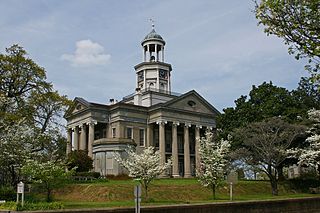
Vicksburg is a historic city in Warren County, Mississippi, United States. It is the county seat and has a population as of 2020 of 21,573. Located on a high bluff on the east bank of the Mississippi River across from Louisiana, Vicksburg was built by French colonists in 1719. The outpost withstood an attack from the native Natchez people. It was incorporated as Vicksburg in 1825 after Methodist missionary Newitt Vick. The area that is now Vicksburg was long occupied by the Natchez Native Americans as part of their historical territory along the Mississippi. The first Europeans who settled the area were French colonists who built Fort Saint Pierre in 1719 on the high bluffs overlooking the Yazoo River at present-day Redwood. They conducted fur trading with the Natchez and others, and started plantations. During the American Civil War, it was a key Confederate river-port, and its July 1863 surrender to Ulysses S. Grant, along with the concurrent Battle of Gettysburg, marked the turning-point of the war. After the war came Reconstruction and then a violent return to power by white supremacists and the Democrat Party in 1874 and 1875, including the Vicksburg massacre. Vicksburg's population is majority African American. The city is home to three large installations of the United States Army Corps of Engineers, which has often been involved in local flood control.

A steamboat is a boat that is propelled primarily by steam power, typically driving propellers or paddlewheels. Steamboats sometimes use the prefix designation SS, S.S. or S/S or PS ; however, these designations are most often used for steamships.
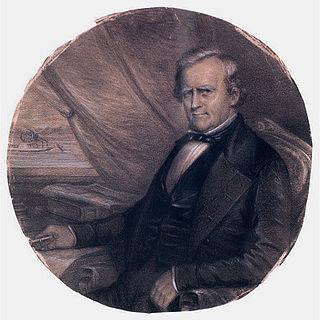
Henry Miller Shreve was an American inventor and steamboat captain who removed obstructions to navigation of the Mississippi, Ohio and Red rivers. Shreveport, Louisiana was named in his honor.

Sultana was a commercial side-wheel steamboat which exploded and sank on the Mississippi River on April 27, 1865, killing 1,167 people in what remains the worst maritime disaster in United States history.

The Great Natchez tornado hit Natchez, Mississippi, on Thursday, May 7, 1840. The tornado was the second-deadliest tornado in United States history; at least 317 people were killed and at least 109 were injured. While officially unrated, it is retrospectively estimated to have been an extremely violent F5 tornado on the Fujita scale. Its 35-mile-long (56 km), 1,000-yard-wide path was marked by severe damage and uncertain estimates of casualties, though many enslaved Africans—possibly numbering in the hundreds—reportedly died on plantations in Louisiana.

Downtown Memphis, Tennessee is the central business district of Memphis, Tennessee and is located along the Mississippi River between Interstate 40 to the north, Interstate 55 to the south and I-240 to the east, where it abuts Midtown Memphis.

The Delta Queen is an American sternwheel steamboat. She is known for cruising the major rivers that constitute the tributaries of the Mississippi River, particularly in the American South, although she began service in California on the Sacramento River delta for which she gets her name. She was docked in Chattanooga, Tennessee and served as a floating hotel until purchased by the newly formed Delta Queen Steamboat Company. She was towed to Houma, Louisiana, in March 2015 for refurbishing to her original condition.
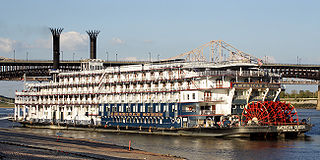

The Monongahela and Ohio Steam Boat Company was the second company to engage in steamboat commerce on the rivers west of the Allegheny Mountains. The company was founded in 1813 under the leadership of Elisha Hunt and headquartered in his store which was located close to the boat landing in Brownsville, Pennsylvania. Daniel French designed and built the engines and power trains for both the Despatch, or Dispatch, and the Enterprise. During the Battle of New Orleans in 1815, the shareholders of the Monongahela and Ohio Steam Boat Company sent the Enterprise to aid the American cause. In 1815, the Enterprise demonstrated for the first time by her epic 2,200-mile voyage from New Orleans to Brownsville that steamboat commerce was practical on America's western rivers.

Natchez has been the name of several steamboats, and four naval vessels, each named after the city of Natchez, Mississippi or the Natchez people. The current one has been in operation since 1975. The previous Natchez were all operated in the nineteenth century, most by Captain Thomas P. Leathers. Each of the steamboats since Leathers' first had as its ensign a cotton bale between its stacks.

President is a steamboat that currently lies dismantled in Effingham, Illinois, United States. Originally named Cincinnati, it was built in 1924 and is the only remaining "Western Rivers" style sidewheel river excursion steamboat in the United States. She was listed on the National Register of Historic Places and declared a National Historic Landmark in 1989, although these designations were revoked in 2011. Her home ports have been Cincinnati, Ohio; New Orleans, Louisiana; Vicksburg, Mississippi; St. Louis, Missouri; and Davenport, Iowa.

The steamboat Enterprise demonstrated for the first time by her epic 2,200-mile (3,500 km) voyage from New Orleans to Brownsville, Pennsylvania, that steamboat commerce was practical on the Mississippi River and its tributaries.

Robert E. Lee, nicknamed the "Monarch of the Mississippi," was a steamboat built in New Albany, Indiana, in 1866. The hull was designed by DeWitt Hill, and the riverboat cost more than $200,000 to build. She was named for General Robert E. Lee, General in Chief of the Armies of the Confederate States. The steamboat gained its greatest fame for racing and beating the then-current speed record holder, Natchez, in an 1870 steamboat race.

New Orleans was the first steamboat on the western waters of the United States. Owned by Robert Fulton and Robert R. Livingston, and built by Nicholas Roosevelt, its 1811–1812 voyage from Pittsburgh, Pennsylvania, to New Orleans, Louisiana, on the Ohio and Mississippi rivers ushered in the era of commercial steamboat navigation on the western and mid-western continental rivers.
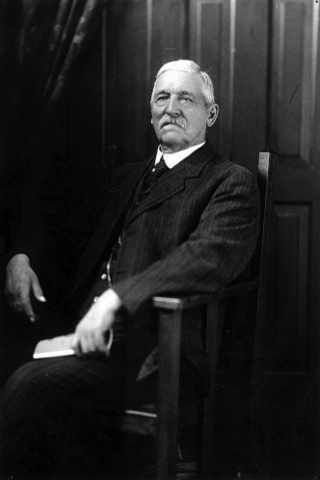
Grant Prince Marsh was a riverboat pilot and captain who was noted for his many piloting exploits on the upper Missouri River and the Yellowstone River in the Western United States from 1862 until 1882. He began working as a cabin boy in 1856, eventually becoming a captain, pilot, and owner in a career lasting over sixty years. During that time, he achieved an outstanding record and reputation as a steamboat captain, serving on more than 22 vessels. His piloting exploits became legendary and modern historians have referred to him as "possibly the greatest steamboat man ever", "possibly the greatest [steamboat pilot] ever", "possibly the finest riverboat pilot who ever lived", and "the greatest steamboat master and pilot on both the Missouri and Yellowstone Rivers".
Streckfus Steamers was a company started in 1910 by John Streckfus Sr. (1856–1925) born in Edgington, Illinois. He started a steam packet business in the 1880s, but transitioned his fleet to the river excursion business around the turn of the century. In 1907, he incorporated Streckfus Steamers to raise capital and expand his riverboat excursion business. A few years later, the firm acquired the Diamond Jo Line, a steamboat packet company.
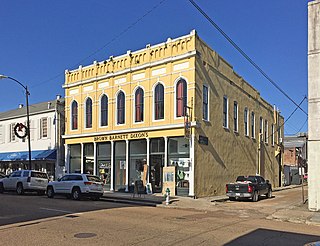
The Norman Studio in photography refers to the family business run principally by photographers Henry C. Norman (1850—1913) and his son Earl Norman (1888—1951) in Natchez, Mississippi between 1876 and 1951, which produced around 75,000 images documenting many significant types of events and subjects in the various small towns along the lower Mississippi River. Its output remains one of the most valuable and comprehensive visual collections documenting Southern American life during the late nineteenth and early twentieth centuries.

The United States Lighthouse Tender Joseph Henry was a lighthouse tender that operated from 1880–1904 primarily on the Mississippi and Missouri Rivers. This steamboat was built by James Howard's company in Jeffersonville, Indiana at his shipyards on the Ohio river in 1880.























